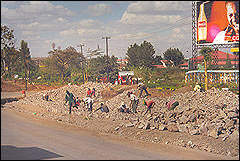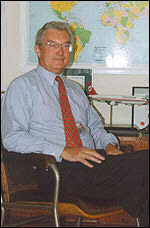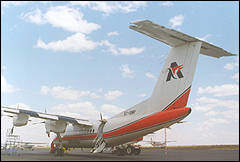 TRANSPORTS AND COMMUNICATIONS: THE CHALLENGE TRANSPORTS AND COMMUNICATIONS: THE CHALLENGE |
One of the first things investors look at when selecting a potential destination where to establish themselves is the state of infrastructures and communications. Kenya is strategically located by the Indian Ocean possessing the largest port in the region. It has an extensive road system (8,137 Km of paved roads) reaching Central Africa, Sudan, Tanzania, Uganda and Kenya. The railroad ties the Kenyan coast to Uganda, servicing even Rwanda and Burundi. It counts with direct flights to the largest European, Middle Eastern and African capitals, as well as to the Indian Subcontinent. Many of these aspects need upgrading and improvements, but they are all there.
 EL NIÑO PHENOMENON VS. THE ROAD NETWORK EL NIÑO PHENOMENON VS. THE ROAD NETWORK |

The poor state of roads seems to be the main complain uttered by businessmen in the industrial and agricultural sectors, since it really affects their performance. The 1997-98 El Niño torrential rains destroyed large chunks of the main road communications network. This, paired with the excessive weight carried by overloaded trucks uncovered the poor maintenance record of the roads. At the time of its independence, Kenya had 1,811 Km of paved roads. Today that figure has multiplied by 4, but when most roads were constructed the carrying capacity was 7 tons. A new batch of vehicles able to transport heavier loads have severely hurt the state of roads. The heavily transited Nairobi-Mombasa corridor used to take about 5 hours to cover. After the rains it takes at least 8 hours to drive the same distance. In some areas the pot-holes are so large they look more like lunar craters. If it rains the trip can take up to 12 hours or more. Given the poor state of the roads, the government has set up a series of priorities. According to Hon. Katana Ngala, former Minister of Public Works and Housing (present Minister of Home Affairs, Heritage and Sports), their first priority is to maintain the existing roads. Secondly they want to ensure road maintenance and finally to provide links to areas where the absence of roads has brought problems and where the movement of goods is on a bottleneck. The European Union has donated some funds for the reconstruction of roads, however, they are particularly concerned with the truck axle limits in order to ensure that road maintenance has an effect.
 ONE OF THE OLDEST RAILROAD SYSTEMS IN AFRICA ONE OF THE OLDEST RAILROAD SYSTEMS IN AFRICA |
The heavy rains provoked by El Niño created havoc. Cargo was held-up for days on end, greatly harming trade, especially of perishable goods. Due to the deterioration of roads, many industrialists, agricultural firms and commercial operations opted to transport their goods via railways. Kenya Railways did not suffer that much from the heavy rains, but they found it difficult to cope with the increased volumes of cargo being offered to them due to a shortage of professional staff, locomotives and a rudimentary and slow administration.
Kenya Railways is probably the oldest running transport institution in the country, in all senses. After the East African Railways (Kenya, Tanzania & Uganda) broke up due to serious political differences, Kenya went its own way creating Kenya Railways in 1978. Even though the network is still common to the three countries, Kenya is the hub and the interconnecting link of the East African Region. However, due to past financial problems, their equipment has rapidly deteriorated or has become obsolete: wagons are getting old as so are locomotives and tracks. In 1997 Kenya Railways signed an agreement with General Electric (GE) intended to re-engineer the main line locomotives. "A US$ 3 million program aimed at rehabilitating wagons is also well underway, commented" the Managing Director Eng. Nyamunga. But they still desperately need to inject funds to improve the tracks.
Kenya Railways is one of the strategic parastatals going to be privatized in the next 2 years. Eng. Nyamunga mentioned that a private consulting firm has completed a study stating the two options for privatization, i.e. private concessions (leasing tracks, wagons, etc) or through a strategic partner. Actually, the government has privatized part of the rail network, the one being used by the soda ash mining company Magadi Soda. When compared to the main railway system, it is quite well maintained and efficient, but they start running into trouble precisely when hitting the main railway line to Mombasa.
Presently Kenya Railways has 5,000 wagons (an active fleet of 3,000), an annual turnover of Ksh 4.5 bill (1998-99) and 11,000 employees, although these will be reduced to 8,500 in the next couple of years as part of cost-cutting measures.
Trains only operate with passengers between Mombasa and Nairobi, the rest of the destinations are for cargo only. Mr. Paul Thomsom, Resident Representative of East African Conference Lines, a group of shipping lines operating between Europe and East Africa, protests: "you often have a situation where empty wagons are sitting up-country, whereas down in the port of Mombasa there is a backlog of over 900 containers waiting to move up-country. There is this crazy idea that the wagons have to wait up-country until there is enough cargo to come down to the port, and given the trade imbalance between imports and exports, there is a constant backlog of empty wagons up-country and a backlog of containers at the port".
 A PORT WAITING TO BE PRIVATIZED A PORT WAITING TO BE PRIVATIZED |
The Port of Mombasa is the largest harbor of East Africa. It connects Kenya and its land-locked neighbors to the rest of the world. Being at a privileged position in the Indian Ocean, the shipping lines established in it operate mainly with East and South Africa, Europe, the Middle East and Asia. However, there are roaring complaints about its poor performance record. One of the priorities of President Moi is to accelerate its modernization and to improve its performance.
The port is managed by the Kenya Ports Authority. In 1996 its management was changed by a new one which resigned the year after. In September 1999, the Managing Director was sacked by Dr. Leaky, Head of the Public Service, due to alleged corruption, mismanagement and poor productivity. He was substituted by a more competent heir. The task ahead of him is monumental. The port users protest of serious and continuous delays and hod-ups and the lack of transparency of the clearing of cargo. Some containers have been opened and their goods stolen. Hon. Ole Ntimama, ex-Minister of Transport and Communications (present Minister of State, Office of the President), claims that "we should be able to overcome these problems as we enter the real privatization stage, where we will privatize the berths and people will take care of their own things". | In 1998 the Port of Mombasa experienced one of its worst crises ever, being on the verge of total collapse. At one point boats were forced to wait up to 21 days to load or unload. Port productivity is measured in terms of container moves per day explains Mr. Thomsom, Resident Representative of East African Conference Lines. At that point our vessels were down to 80 moves/day, whereas in Europe the normal rate of discharge of load averages about 400 moves (Singapore has 900 moves per 24 hours!). The situation got so dramatic that E.A. Conference Lines proposed to the government to have a berth run by themselves. The government accepted. Today the productivity at the dedicated berth is 220 moves/day. Mr. Thomsom further points out that a major problem is the state of repair of the ship-so-shore gantries, which break down constantly. The government, after much lobbying and pressure, committed the Port to purchase the necessary parts and equipment. "If we can get the gantries working, we could achieve up to 350 moves per 24 hours, most of our problems would be solved and we would have a reasonably efficient, fast moving port", argues Mr. Thomsom. Other ports of the region, such as Dar-es-Salam, in Tanzania, are actively trying to draw customers away from the Port of Mombasa. The Dar-es-Salam port is smaller but it is reputed to have better services and to clear cargo faster. However, "we are not competing against Tanzania, we are competing against international standards" stresses the Resident Representative. The attitude that "it is working, it is OK, this is Africa" has to change giving way to an upgrading of standards and a change of the work ethics.
 KENYA AIRWAYS: A CASE STUDY KENYA AIRWAYS: A CASE STUDY |

A good example of this change of attitude is Kenya Airways, the biggest success in the privatization process of Kenya. For 18 years the Kenyan national carrier was making loses which totaled up to Ksh 4.3 billion (US$ 57 million). The company was set for privatization and a strategic partner was sought. The partner was not only to bring a fresh injection of funds, but technical expertise and experience in partnerships. KLM was chosen among 154 airlines worldwide for precisely this reason: it has signed 29 international agreements with other airlines all over the world. KLM not only bought 26% of the total shares of Kenya Airways, they have also entered into sales and advertising sharing agreements. Through Northwestern (another of KLM´s partners) Kenya's largest airline also covers several destinations in the US. They are trying to offer direct access to the main African destinations, since the continent is still poorly serviced, and in many instances the trips from East to West Africa have to be done via Europe. "In 1993 Kenya Airways made its first trading profit; since then it has only made gains", boasts Mr. Brian Davies, the English Managing Director and Chief Executive of the company that helped realize this miracle. Today Kenya Airways' turnover is US$ 208 million, it has 2,500 employees, and they operate in 23 different countries. Mr. Davies, with the conscience quite clean, stepped down in July 1999, and with a sense of mission accomplished he informed us he was going to take a sabbatical year to design his own airplane. Mr. Nyagah has taken over the management of the firm.
During the COMESA summit in Mombasa, the regional policy of Open-Skies was approved allowing competition within the COMESA area. The first liberalization aspects were implemented October 1st 1999. Being the designated airline, Kenya Airways was protected by the government as part of the privatization deal. For 5 years from the date of the agreement with KLM, it was established that the government would not give cross-border traffic rights to any other airline. But with the new open-skies policy now being implemented, all that has changed. This signifies that Kenya Airways will have to face some stiff competitors, not only from outside, but also from within. Competition might not necessarily come from large foreign carriers, but from smaller and suppler airlines, such as Air Kenya.
 AIR KENYA: THE SUN-BIRD AIR KENYA: THE SUN-BIRD |

Air Kenya's history is only 12 years old (it was founded in 1987). Since its start it looked for a niche in the transportation of tourists to the National Game Parks. In order to fly travelers to the wild game reserves, only small aircrafts can be used. Air Kenya's largest airplane seats 50 people. They have the perfect size to cover those destinations for which there is a high demand of well-off tourists. Today 75% of Air Kenya's business are scheduled flights. So far they only compete head on with Air Kenya on the Nairobi-Mombasa-Lamu route. But with the new Open-Skies policies, Air Kenya has suddenly seen their prayers answered. Prior to the COMESA summit, no other airline could operate across borders. Mr. John Buckley, its Managing Director points out that they even had to set up a daughter company under a different name (Regional Air Service) to cover the ever-growing Tanzanian market. Now they see their business expanding cross-borders to destinations that so far are not sufficiently serviced such as the Nairobi-Zanzibar route or Uganda, Zambia, and other countries in the region.
Compared to Kenya Airway´s arrogant and incompetent staff, Air Kenya's beautiful and helpful airhostesses seem every traveler's dream. Service is impeccable, and hardly ever anything goes wrong. Probably for these reasons in 1998 the Wilson Airport, their cozy center of operations, registered 155,000 passengers in their scheduled flights. Kenya Air 235 permanent employees know how to make you feel at home but also what their business is all about. Their turnover in 1998 reached US$ 15 million. It seems that their logo, a red and black sun-bird was chosen with a clear purpose in mind:" reach for the skies". |

